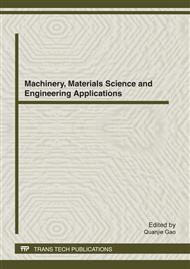p.191
p.196
p.200
p.205
p.211
p.218
p.222
p.227
p.233
Driving Dynamic Analysis and Motion Control for Biped-Imitating Walking Mechanism
Abstract:
According to the asymmetry characteristics of animal motion, a new walking mechanism called Biped-Imitating Walking Mechanism (BIWM) which can generate asymmetry motion was presented. Based on introducing the assembly relation and walking principle of BIWM, the driving torque of driving shaft was deduced by Lagrange Equation under three walking conditions:flat, upgrade, and downgrade walking. In addition, the peak of driving torque could be decreased to the minimum by optimizing motor speed, by which the power and size of motor coulde be further reduced. A case study by ADAMS software is finally given to verify the accuracy of theoretical derivation and optimization of motion control. The above research results would provide some helpful advices for BIWM application.
Info:
Periodical:
Pages:
211-217
Citation:
Online since:
April 2012
Authors:
Price:
Сopyright:
© 2012 Trans Tech Publications Ltd. All Rights Reserved
Share:
Citation:


